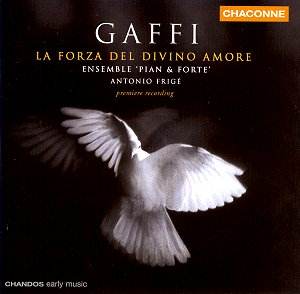Time and again the
lists of new CD-releases contain names
of Italian composers most people have
never have heard of. To some extent
this reflects the fact that Italian
music history, in particular of the
decades around 1700, hasn't been fully
explored yet. But it also shows the
large demand for music in Italy, where
princes and dukes, cardinals and bishops
wanted to demonstrate their power and
status by attracting the best musicians
and composers available. And since music
was a part of everyday life, like food
and drink, there were plenty of opportunities
for performers and composers to make
a living.
Gaffi was born in Rome
and spent his whole life in the city.
He was educated as a keyboard player
by Bernardo Pasquini, the leading keyboard
virtuoso in Rome in the second half
of the 17th century. He became organist
at several of Rome's churches during
his life, the most important of which
were those previously held by Pasquini.
Performances of vocal music were an
important feature of musical life at
the courts in Rome. Gaffi took part
in a number of them as a harpsichordist,
among others those organised by Cardinal
Pamphili and Cardinal Ottoboni. He also
became connected to Prince Francesco
Maria Ruspoli, who commissioned three
mass settings, and to whom Gaffi dedicated
his only opus which was published during
his life: a set of chamber cantatas,
which was another genre which was in
huge demand in those days. In these
cantatas he showed himself an original
composer by giving the harpsichord a
concertante role.
Gaffi composed eight
oratorios - most of them in the last
decade of the 17th century - which were
not only performed in Rome, but also
in Florence, Venice and Vienna. One
of these is the one recorded here, which
is about the life of a saint: St Teresa
of Avila (1515 - 1582), the Carmelite
mystic who founded a number of convents
and monasteries in Spain. In this oratorio
the allegorical figure of Divine Love
calls men and women to take up arms
and suffer and die for Jesus. Teresa
wants to answer to that call, and her
younger brother Rodrigo is ready to
join her. In the second part they renounce
all earthly pleasures and prepare to
follow Divine Love's call. But she then
asks them to return home, as they have
already proven their faith. Teresa obeys,
as it is the will of Heaven that she
becomes a messenger of Divine Love and
brings glory to the Carmelite Order.
The oratorio ends with the line: "For
the glory of the Carmelites, the honour
of heaven."
This is very likely
the first recording of any work by Gaffi.
Is it worth the effort? That depends
on what one expects. There was an enormous
need for music during the 17th and 18th
centuries. Originality wasn't the main
demand, and music certainly wasn't written
for eternity. For simple statistical
reasons one cannot expect every single
work from that era to be a masterpiece.
And I think this oratorio isn't either.
I find it somewhat uneven in quality.
There are some very fine arias, with
a lot of text expression, like St Teresa's
arias "Che posso dir io" and "Deh pietà,
Signor mercé", both in the second
part. And her aria "Piacere terreni"
is the highlight of the first part of
the oratorio, in which the violins illustrate
her exclamation "Piaceri terreni ...
partite fuggite" (earthly pleasures
... go, fly). Earlier in the oratorio
the trumpet is used in some arias with
a martial character, in particular,
of course, in Divine Love's aria "Già
suona la tromba" (The trumpet is sounding).
But in some arias and recitatives possibilities
to express the text in the music pass
by unnoticed.
As the quality of the
oratorio is uneven, so is the performance.
The ensemble is fine, and I have nothing
but praise for the way Gabriele Cassone
is playing the trumpet part, even though
I suspect his instrument is 'fixed'
in order to play in tune.
Of the three vocal
roles that of St Teresa is the most
interesting and musically demanding,
and it is impressively performed by
Marivì Blasco. She has got a
beautiful and flexible voice, which
is excellently suited to this role.
The Czech soprano Leona Peleskova has
a somewhat darker and lower voice. I
would rather label her a mezzo-soprano.
It is perhaps due to the fact that she
isn't a native Italian speaker that
her performance is a little stiff, in
particular in the recitatives. Her diction
isn't flawless either. Sergio Foresti
doesn't have any problems in this regard,
but in his attempts to sing expressively
he tends to exaggerate sometimes, with
a hint of sentimentality. He is at his
best in his duets with Marivì
Blasco, where both voices blend quite
well.
To sum up, this recording
is hardly a 'must', but there is enough
to enjoy in order to recommend it to
those interested in the Italian vocal
music around 1700, which until recently
was so grossly neglected by musicians
and record companies alike. A disc like
this reminds us that thankfully a lot
has changed in this respect.
Johan van Veen







